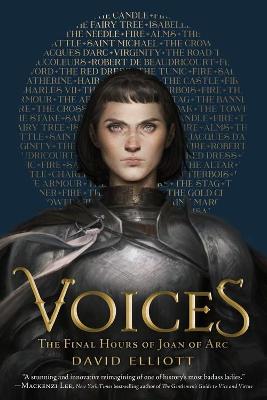Reviewed by Briana @ Pages Unbound on
First, I think the book doesn't take Joan's religion seriously, which is a problem I have in general when authors tackle religious figures and try to write them for a popular, secular audience. Elliott doesn't seem comfortable suggesting that Joan believes her own visions or that anyone else believes her. He has a whole poem from St. Michael's point of view that suggests he may or may not be real and ponders whether, if he is real, he can really be counted as a saint. (Which seems to overlook the Catholic definition that a saint is anyone in heaven so, yes, if Michael the Archangel is real he is 100% a saint; this has nothing to do with whether he feels his personality or actions deserve the title.) Another poem from St. Margaret reflects that "saints are just human" and she can't really do anything to help Joan, which also seems counter to actual Catholic teaching. The book obviously doesn't need to support Catholicism, but I do think a book that is about a Catholic saint and seems to be trying to celebrate that person should, in fact, take their religion and religious beliefs seriously instead of trying to minimize them.
I also have concerns about the discussion of gender. Elliott's portrayal of Joan is one (a stereotypical YA one?) of a young girl who never liked doing girly things like sewing, who hated wearing dresses, who always dreamed of going to war, and who says she is more comfortable in the military than anywhere else. There is no historical evidence to support this. Of course Joan and her supporters would have reason to lie and make her seem content with "women's work," but all the evidence we have suggests that Joan was a "good girl," a quiet religious girl who was good at sewing and such and never gave anyone the impression she was itching to throw away her mending, rip off her dress, and go to war.
Elliott further suggests that Joan was uncomfortable wearing women's clothes and feeling men's clothes felt "right" to her. Perhaps, but this is speculation on Elliott's part, a suggestion that perhaps she really did feel like or yearn to be a man. Historical evidence, on the other hand, suggests that she dressed as a man primarily to avoid being raped. She didn't want to obviously look like a woman when surrounded by men. Furthermore, historical evidence shows she had a number of fastenings and ties added to her clothing that would have been unusual on the average menswear--presumably to make it harder for someone to forcibly take it off her. The records are also clear that she regularly slept fully clothed AND fully armed; again, presumably for her personal safety. Elliott glosses over all of this.
Finally, the book suggests that Joan was primarily killed for acting/dressing like a man. Certainly this was a sticking point in her trial, part of the evidence that she was unnatural, possibly a witch. However, it's clear that she was killed by the English because, well, she was French and winning battles for the French. Again, Elliott completely overlooks an important medieval discussion: the fine line between being a saint and a witch for women in the Middle Ages. Joans actions were praised by the French and condemned by the English; the French thought she was from God, and the English thought she was the devil. This was obviously for political reasons, and she was not killed for acting like a man. I think if Elliott had even really dipped his toes into medieval scholarship or discussions surrounding Joan, the witch/saint dichotomy would have been evident to him, and it should have played a larger role in this book.
It's clear from reading other Goodreads reviews that I am currently the only one taking these types of issues with the book. If you just want an overview of Joan's life and to get a general sense of what she did and how others responded, this certainly will work as an introduction. I think anyone who has a particular interest in Joan and has read a lot about her will be disappointed by how speculative this is and how it seems grounded more in the author's opinions and interpretations than solid research.
Reading updates
- Started reading
- 16 January, 2019: Finished reading
- 16 January, 2019: Reviewed
